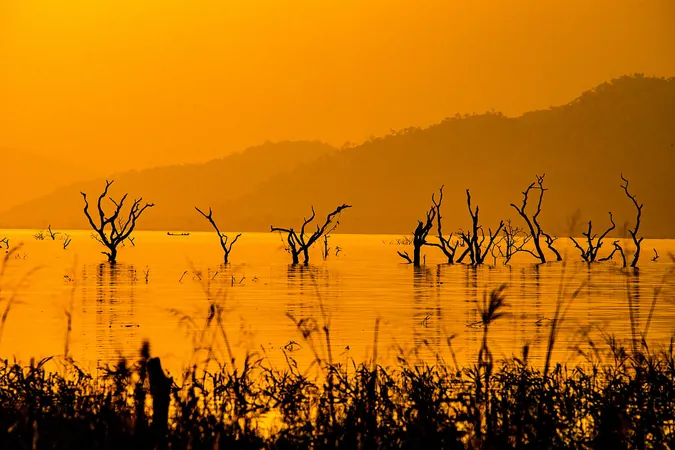
The Deadly Reality of West Africa’s Harmattan Winds: It’s Not Just Dust!
2025-04-02
Author: Yu
Every year, from December through April, a sinister force known as the Harmattan sweeps across West Africa. This dry, cool, and dust-laden wind, named after the Ghanaian term "haramata," not only shrouds the region in dust but also brings a host of health hazards that can be deadly.
Originating from high-pressure systems over the Sahara—specifically south of Algeria and Libya, and north of Mali, Mauritania, Niger, and Chad—the Harmattan significantly alters the climatic landscape of West Africa. The drill of decreased visibility and extreme dryness is well-known, but the real danger lurks beneath the surface.
What Exactly Causes the Harmattan?
During the boreal winter months (October to March), atmospheric circulation patterns shift southward, pulling the inter-tropical convergence zone, where moist and dry air collide, towards the Gulf of Guinea. What follows is the sustained influence of the Harmattan across much of West Africa, driven by significant atmospheric pressure differences.
The higher pressure systems push down dry air from altitudes, while low-pressure zones near the equator create violent storms. Thus, the contrasting air flows give rise to the persistent, bone-dry winds synonymous with the Harmattan. With these winds come extremely low humidity levels and conditions that can lead to severe health issues.
The Health Impact: A Risky Breath
As the Harmattan carries with it a cocktail of dust, microbes, and various harmful pathogens, the health consequences are alarming. It is linked to a surge in skin conditions and respiratory ailments like bronchitis, pneumonia, and asthma. But the risks extend even further. Special attention must be paid to its role in the alarming spread of diseases such as influenza and Tuberculosis, a notorious illness exacerbated by the dry air. Disturbingly, research indicates that air quality deteriorates dramatically during these months, with a reported 15 percent increase in fine dust particle concentrations correlating with a staggering 24 percent rise in infant mortality rates.
Health experts have roundly criticized the lack of adequate monitoring systems to warn at-risk populations in time. The race against time is paramount as these deadly winds cause localized outbreaks and strain already fragile healthcare systems in the Sahel.
The Ecosystem Under Siege
The implications don't stop at human health. The Harmattan wreaks havoc on local ecosystems by accelerating soil erosion and evaporating surface water at alarming rates. Additionally, the dust obstructs visibility for aircraft and hampers the efficiency of solar farms—an essential resource in a region with powerful sunlight.
A Call to Action: Protecting Lives and Environments
Numerous research and measurement campaigns, particularly through the European Copernicus program, have been initiated to understand how dust plumes are formed and transported. Recognizing the gravity of the situation, scientists and meteorological services in Sahelian countries are developing user-friendly indicators and simplified early warning systems to alert vulnerable populations.
To mitigate the harmful effects, individuals are encouraged to take preventive measures. Using masks, saline solutions for airways, and getting vaccinated can significantly reduce health risks. Furthermore, strengthening air quality monitoring systems in urban centers could improve responses to dust-related health mandates.
The end of the Harmattan season in April signals not just the arrival of warmer temperatures but also a worsening in air quality that can lead to serious health problems during subsequent heatwaves. An urgent need exists for improved monitoring networks across West Africa to accurately predict these hazards and protect the populace from the lethal consequences of this seemingly harmless wind.
The time to act is now. As the Harmattan continues its yearly assault, West Africa must stand united to combat the hidden dangers of these winds. Don’t wait for the dust to settle—understand the menace today!



 Brasil (PT)
Brasil (PT)
 Canada (EN)
Canada (EN)
 Chile (ES)
Chile (ES)
 Česko (CS)
Česko (CS)
 대한민국 (KO)
대한민국 (KO)
 España (ES)
España (ES)
 France (FR)
France (FR)
 Hong Kong (EN)
Hong Kong (EN)
 Italia (IT)
Italia (IT)
 日本 (JA)
日本 (JA)
 Magyarország (HU)
Magyarország (HU)
 Norge (NO)
Norge (NO)
 Polska (PL)
Polska (PL)
 Schweiz (DE)
Schweiz (DE)
 Singapore (EN)
Singapore (EN)
 Sverige (SV)
Sverige (SV)
 Suomi (FI)
Suomi (FI)
 Türkiye (TR)
Türkiye (TR)
 الإمارات العربية المتحدة (AR)
الإمارات العربية المتحدة (AR)